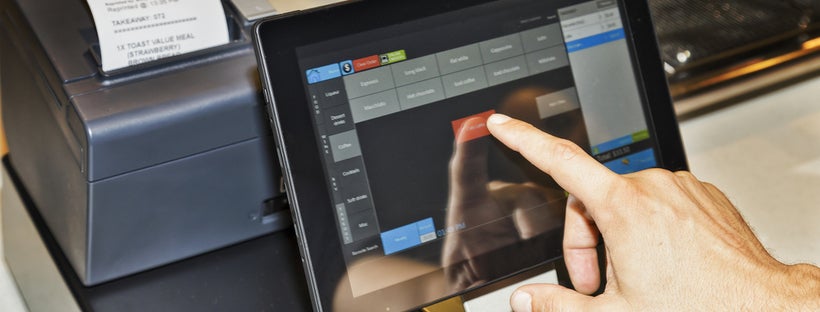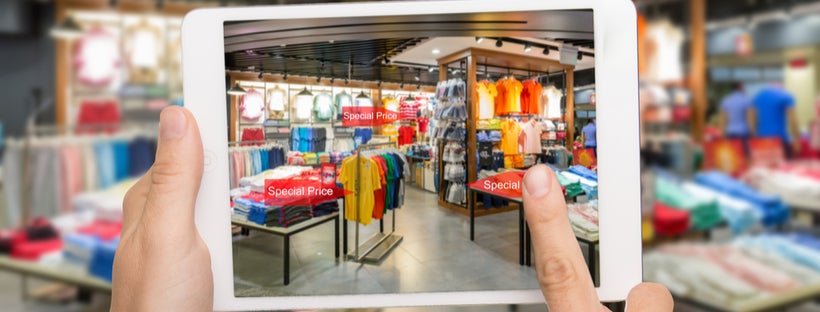Mobile marketing through software applications is a common way for businesses to offer new services while gathering data on their customers. However, along with getting your customers to install an app, tablets and smartphones offer powerful new ways to allow brands to streamline the overall customer experience in retail spaces.
Custom applications can offer faster checkout times and easy access to inventory on the go. With a little creativity and the right hardware, there are many ways you can use these devices to increase sales and offer a better experience to customers. Here’s seven advantages for integrating custom applications and tablets into the retail space.
Convenience of Self-Service Touchpoints
By integrating your ecommerce and retail sales platforms, you can offer tablets as a self service touchpoint for your customers. This allows you to enhance the customer experience by giving shoppers the opportunity to browse your products online while at your physical location.
With tablets, customers can easily see products or variations of products that become difficult to display on-site. They can browse your entire inventory with a few taps on the devices. Such self-service kiosks also allow easy integration with loyalty programs for purchases, and reduces the amount of service staff needed for simple transactions.
If you’re building a self-service kiosk, just place a series of tables on tablet display stands and use the appropriate signage to notify customers of the service.
Maximize Floor Space

Tablets equipped with point of sale (POS) software allow marketers and retailers to maximize their floor space by streamlining checkout points. By maximizing floor space, you can offer a wider range of inventory to your clients along with more room to display inventory.
POS software also acts as a powerful source of information for the customer. With the ability to check inventory and research products, brands can reduce indecision on the customer end, and encourage interactions with sales associates for options in terms of size, color, and styles.
By opening up floor space, you also have more room to provide additional merchandise. An open floor makes it easy to rotate seasonal products, and showcase frequently purchased products.
Cutting the Long Queues
Every business today wants to offer frictionless experiences to their clients, where the entire journey from product discovery to sale is streamlined. For physical, brick-and-mortar businesses, one of the best ways to improve customer experience and reduce friction is to minimize the total time spent in queues.
By offering physical self-service kiosks, as well as downloadable applications, you can offer a mobile Point of Sale, allowing a retailer to take the checkout to the customer. This not only frees up your register, but reduces the time your customer spends waiting in line at the physical location.
The Mobile Billboard
While tablets can be interactive, they can also act as flexible, accessible, and instantly changeable ad space. By installing tablets or other screens into the store, you can provide instant marketing materials. from photo displays to detailed tutorials. You can also use these platforms to flash special deals, promotions, and offers with the push of a button.
Streamline Your Workflow

Along with customer interactions, tablet technology can be utilized to help your employees work more efficiently. With a digital inventory system, tablets allow staff to check stock levels instantly, source stock from other locations, and research on behalf of the customer in real time.
Tablets also allow your sales associates to complete transactions from almost anywhere in the store. For boutiques and concierge customer experiences, this allows your sales associates to instantly provide checkout, greatly improving the buying experience for customers.
Leveraging Data
Digital inventory and POS technology also brings another benefit of eCommerce into retail: customer data. Kiosks and digital checkouts are excellent ways to collect customer feedback.
Just include a short survey at the end of the purchase utilizing in-store tablets. To incentivise the customer, offer them some sort of coupon or discount in return for their participation. This type of research will give you deeper insights into what your customers expect from your brand, and allow you to adjust your offerings to their changing needs.
Digital POS systems also can conveniently pull data and reports and gather analytics. Through a simple loyalty program, you can gather demographic data on your customer base. Likewise, by analyzing the speed of transactions and sales provided, you can track which products and sales team members are performing the best and adapt your marketing strategy accordingly.
Improve Product Visualization

While product demonstrations are powerful methods to persuading purchases, many brick-and-mortar businesses struggle to provide them due to limited space and time. In-store tablets can be a great tool here to showcase detailed product demonstrations and improve product visualization.
Apart from demonstrating how a product functions overall, tablets also help consumers explore and view options with visual detail. For example, a clothing store might use a tablet to demonstrate to a customer various fabric and sizing options for better product visualization.
If you utilize tablets for product visualization, make sure to use professional, high res photography and videography to make your products look their best. In addition, ensure your application is well designed and aesthetically pleasing. Otherwise, you’ll leave your customers with a poor impression of your brand, irrelevant to the quality of your product.


 Posted in
Posted in